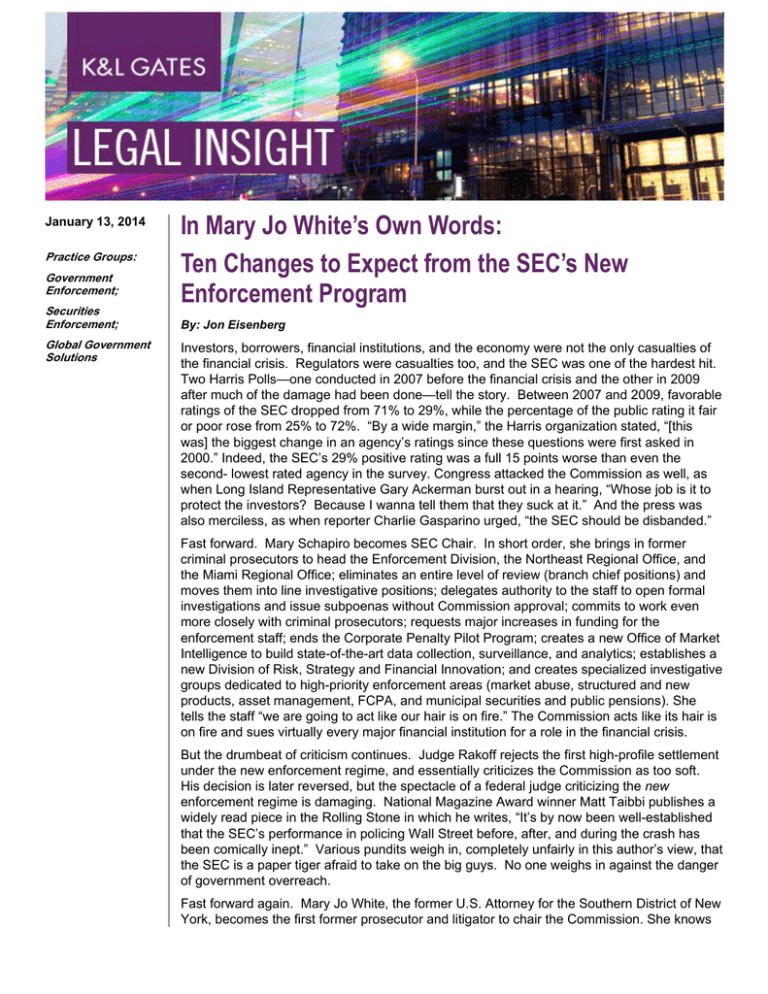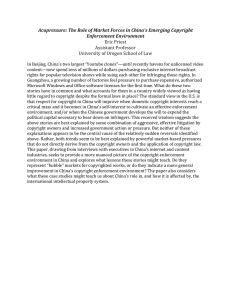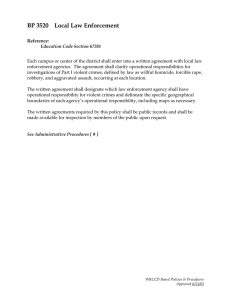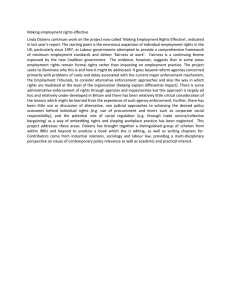
January 13, 2014
Practice Groups:
Government
Enforcement;
Securities
Enforcement;
Global Government
Solutions
In Mary Jo White’s Own Words:
Ten Changes to Expect from the SEC’s New
Enforcement Program
By: Jon Eisenberg
Investors, borrowers, financial institutions, and the economy were not the only casualties of
the financial crisis. Regulators were casualties too, and the SEC was one of the hardest hit.
Two Harris Polls—one conducted in 2007 before the financial crisis and the other in 2009
after much of the damage had been done—tell the story. Between 2007 and 2009, favorable
ratings of the SEC dropped from 71% to 29%, while the percentage of the public rating it fair
or poor rose from 25% to 72%. “By a wide margin,” the Harris organization stated, “[this
was] the biggest change in an agency’s ratings since these questions were first asked in
2000.” Indeed, the SEC’s 29% positive rating was a full 15 points worse than even the
second- lowest rated agency in the survey. Congress attacked the Commission as well, as
when Long Island Representative Gary Ackerman burst out in a hearing, “Whose job is it to
protect the investors? Because I wanna tell them that they suck at it.” And the press was
also merciless, as when reporter Charlie Gasparino urged, “the SEC should be disbanded.”
Fast forward. Mary Schapiro becomes SEC Chair. In short order, she brings in former
criminal prosecutors to head the Enforcement Division, the Northeast Regional Office, and
the Miami Regional Office; eliminates an entire level of review (branch chief positions) and
moves them into line investigative positions; delegates authority to the staff to open formal
investigations and issue subpoenas without Commission approval; commits to work even
more closely with criminal prosecutors; requests major increases in funding for the
enforcement staff; ends the Corporate Penalty Pilot Program; creates a new Office of Market
Intelligence to build state-of-the-art data collection, surveillance, and analytics; establishes a
new Division of Risk, Strategy and Financial Innovation; and creates specialized investigative
groups dedicated to high-priority enforcement areas (market abuse, structured and new
products, asset management, FCPA, and municipal securities and public pensions). She
tells the staff “we are going to act like our hair is on fire.” The Commission acts like its hair is
on fire and sues virtually every major financial institution for a role in the financial crisis.
But the drumbeat of criticism continues. Judge Rakoff rejects the first high-profile settlement
under the new enforcement regime, and essentially criticizes the Commission as too soft.
His decision is later reversed, but the spectacle of a federal judge criticizing the new
enforcement regime is damaging. National Magazine Award winner Matt Taibbi publishes a
widely read piece in the Rolling Stone in which he writes, “It’s by now been well-established
that the SEC’s performance in policing Wall Street before, after, and during the crash has
been comically inept.” Various pundits weigh in, completely unfairly in this author’s view, that
the SEC is a paper tiger afraid to take on the big guys. No one weighs in against the danger
of government overreach.
Fast forward again. Mary Jo White, the former U.S. Attorney for the Southern District of New
York, becomes the first former prosecutor and litigator to chair the Commission. She knows
In Mary Jo White’s Own Words:
Ten Changes to Expect from the SEC’s New Enforcement
Program
the Commission’s reputation is improving, but she also knows it has not fully recovered. So
what does she say? Let’s look. Because her words are the best roadmap to what you can
expect from the Commission’s enforcement program now and at least over the next few
years:
Going after the Big Guys
“In many ways, the most visible face of the SEC is what we do to enforce the law. After all,
most Americans do not see how well our experts examine a financial firm, review a
regulatory filing, or conduct economic analysis on a complex rule. But they do pay attention
when we bring a major enforcement action against a major financial institution, when we
charge a hedge fund executive with insider trading, when we freeze a suspected Ponzi
schemer’s assets, or when we charge a CEO with fraud.”
“[W]e are continuing to prioritize the bigger cases—pursuing and punishing major offenses
by significant and high-profile market participants, sending a strong message of deterrence
to the industry and boosting the confidence of investors.”
Targeting Gatekeepers
“[W]e are focusing on deficient gatekeepers—pursuing those who should be serving as the
neighborhood watch, but who fail to do their jobs.”
Bringing Enforcement Cases for Even Minor, Unintentional Infractions
“Investors do not want someone who ignores minor violations, and waits for the big one that
brings media attention. Instead, they want someone who understands that even the smallest
infractions have victims, and that the smallest infractions are very often just the first step
toward bigger ones down the road. They deserve an SEC that looks at its enforcement
mission in exactly that way.
“This approach is not unlike the one taken in the nineties by then New York City Mayor Rudy
Giuliani and police Commissioner Bill Bratton….They essentially declared that no infraction
was too small to be uncovered and punished.” [The Commission will pursue] “[n]ot just the
biggest frauds, but also violations such as control failures, negligence-based offenses, and
even violations of prophylactic rules with no intent requirement….”
Suing More Individuals
“Another core principle of any strong enforcement program is to pursue responsible
individuals wherever possible….Individuals tempted to commit wrongdoing must understand
that they risk it all if they do not play by the rules. When people fear for their own
reputations, careers, or pocketbooks, they tend to stay in line….I want to be sure we are
looking first at the individual conduct and working out to the entity, rather than starting with
the entity as a whole and working in.”
2
In Mary Jo White’s Own Words:
Ten Changes to Expect from the SEC’s New Enforcement
Program
Imposing Harsher Financial Penalties
“And when we resolve cases, we need to be certain our settlements have teeth, and send a
strong message of deterrence. That is why in each case, I have encouraged our
enforcement teams to think hard about whether the remedies they are seeking would
sufficiently redress the wrongdoing and cause would-be future offenders to think
twice….[W]e must make aggressive use of our existing penalty authority, recognizing that
meaningful monetary penalties—whether against companies or individuals—play a very
important role in a strong enforcement program.”
Mandating More Undertakings
“Expect to see more such mandatory undertakings in future cases so that we are not just
punishing past wrongs, but also acting to prevent future wrongs.”
Demanding More Admissions
“Candidates potentially requiring admissions include:
• Cases where a large number of investors have been harmed or the conduct was
otherwise egregious.
• Cases where the conduct posed a significant risk to the market or investors.
• Cases where admissions would aid investors deciding whether to deal with a particular
party in the future.
• Cases where reciting unambiguous facts would send an important message to the market
about a particular case.”
Coordinating More Closely With Examination Teams
“We also will be closely coordinating our enforcement teams and our examination teams,
both to ensure that exams are properly focused and that when misconduct is uncovered it is
referred for possible enforcement action.”
Using the Commission’s Enhanced Surveillance Tools
“This broad focus demands that we use all available means to detect and pursue violations.
So we will be taking advantage of tips from whistleblowers, using quantitative data available
to us, and conducting sweeps and other means of uncovering misconduct.”
Trying More Cases
“If, in fact, a result of our change in settlement policy results in more trials, one clear winner
will be the administration of justice, which will always fare best in the open for the public to
see and to take stock of what a defendant did and what its government is doing.”
*****
3
In Mary Jo White’s Own Words:
Ten Changes to Expect from the SEC’s New Enforcement
Program
In short, now and over the next few years, financial institutions can expect an even more
aggressive enforcement program, a greater focus on individuals, tougher penalties for both
small and large infractions and for both companies and individuals, new demands for
admissions, closer coordination between enforcement and the examination team, a greater
ability by the Commission to use its enhanced tools to uncover potential misconduct, and a
greater willingness by the Commission to try tough cases. Good compliance and adequate
resources are critical in all environments, but in this one especially. Government overreach
is a significant danger as the Commission continues efforts to restore its own reputation.
Unfortunately, the only check against overreach, apart from staying out of trouble, is a
willingness of firms to litigate when the Commission insists on bringing weak cases or seeks
penalties out of proportion to what the cases merit. Historically, that’s not been the path that
firms have chosen.
Authors:
Jon Eisenberg
jon.eisenberg@klgates.com
+1.202.778.9348
Anchorage Austin Beijing Berlin Boston Brisbane Brussels Charleston Charlotte Chicago Dallas Doha Dubai Fort Worth Frankfurt
Harrisburg Hong Kong Houston London Los Angeles Melbourne Miami Milan Moscow Newark New York Orange County Palo Alto Paris
Perth Pittsburgh Portland Raleigh Research Triangle Park San Diego San Francisco São Paulo Seattle Seoul Shanghai Singapore Spokane
Sydney Taipei Tokyo Warsaw Washington, D.C. Wilmington
K&L Gates practices out of 48 fully integrated offices located in the United States, Asia, Australia, Europe, the Middle East and South
America and represents leading global corporations, growth and middle-market companies, capital markets participants and
entrepreneurs in every major industry group as well as public sector entities, educational institutions, philanthropic organizations and
individuals. For more information about K&L Gates or its locations, practices and registrations, visit www.klgates.com.
This publication is for informational purposes and does not contain or convey legal advice. The information herein should not be used or relied upon in
regard to any particular facts or circumstances without first consulting a lawyer.
©2013 K&L Gates LLP. All Rights Reserved.
4





